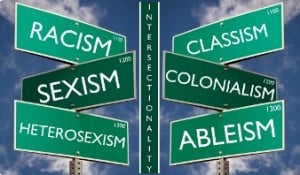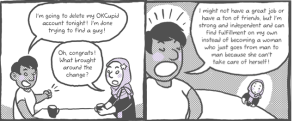
Source: Embracing the Red Queen
If you’re familiar with feminism, you’ll have heard of the term patriarchy – the social order that privileges men and oppresses women. It’s a useful term as it gives a name to the institutionalisation of male privilege.
But feminism has moved on from being purely concerned with male privilege.
We now – thankfully and rightfully! – take into account the number of different privileges and oppressions that people experience.
First named by Kimberlé Crenshaw in 1989, intersectional feminism is concerned with the social order that privileges and oppresses people based on race, gender, language, class, sexual orientation, (dis)ability, culture, and so on.
Intersectional feminism tells us that oppression comes in many different forms. Someone is not simply oppressed or privileged: we can be simultaneously privileged and oppressed by different aspects of our identities.
For example, somebody can be privileged by the fact that they are cisgender, thin, and white, while being oppressed by the fact that they are queer, disabled, and female.
Because of this, we need a word to describe the complex social order that keeps these intersecting oppressions in place.
Kyriarchy is an excellent word for this concept – it is more in line with intersectional feminism, and is not as problematic as the word patriarchy can be.
Kyriarchy 101
The term kyriarchy was coined by Elisabeth Schussler Fiorenza in her 2001 book, Wisdom Ways: Introducing Feminist Biblical Interpretation. In the glossary, she defines kyriarchy as:
a neologism…derived from the Greek words for “lord” or “master” (kyrios) and “to rule or dominate” (archein) which seeks to redefine the analytic category of patriarchy in terms of multiplicative intersecting structures of domination… Kyriarchy is best theorized as a complex pyramidal system of intersecting multiplicative social structures of superordination and subordination, of ruling and oppression.
In other words, the kyriarchy is the social system that keeps all intersecting oppressions in place.
In the glossary of Wisdom Ways, Schussler Fiorenza points out that “the theoretical adequacy of patriarchy has been challenged because, for instance, black men do not have control over white wo/men.”
This is definitely true.
To extend this example, let’s imagine two people: one is a white, cisgender, heterosexual, able-bodied woman. Another is a black, transgender, pansexual, disabled man. According to the theory of patriarchy, the woman would be oppressed and the man would be privileged.
Sure – the woman will experience oppression as a woman, and the man might experience forms of male privilege. But it’s a whole lot more complicated than that.
In this situation, the man would not have control (or economic, social, and political privilege) over the woman. To merely call the man dominant and the woman oppressed without taking any other factors into account would be to erase all the other aspects of their identities.
This is not to say that male privilege can be totally erased because of certain factors. Rather, it means that the way someone experiences male privilege is dynamic and dependent on other identities.
Why Kyriarchy Is Useful for Intersectional Feminism
Oppression is not simply about discrimination. It is about being institutionally and systemically repressed.
Gender-based oppression, for example, is not just about someone making a joke about women belonging only in the kitchen. It’s about women being denied equal access to education, the job market, equal pay, reproductive health services, and legislative equality for centuries.
It’s about the gender-based violence that women experience.
It’s about women being presented as weak, overemotional, lacking sexual desire, irrational, and superficial by institutions such as the media, education system, politicians, legislation, and commercial groups.
It’s about stereotypes – of all sexes – being enforced by these institutions.
It’s about socializing people to believe one gender is superior while the others are inferior. It’s about the social, political, and economic repression of women.
Oppression is not about isolated incidents. It’s about a number of incidents, habits, culture, and tradition enforcing the domination of one group over another.
Effective anti-oppression movements will view oppression as systemic. These movements take into account the fact that oppression can only be eradicated through radical, holistic change.
We therefore need a name for the institutionalisation of oppression. Feminists often call the institutionalisation of sexism “the patriarchy.”
Mainstream feminism has been traditionally concerned with gender inequality. Intersectional feminism, however, is concerned with all types of inequality. The term kyriarchy is useful as it is therefore more in line with intersectional feminism.
1. It acknowledges that gender-based oppression is not the only type of oppression that exists.
We’ll never achieve equality by tackling only sexism.Inequality doesn’t begin and end with sexism – so why should we only recognize a system that keeps gender inequality in place?
Unlike the term patriarchy, which refers only to institutionalized sexism, kyriarchy covers all forms of inequality.
To achieve true, full equality, we need to tackle the systemic oppression of all groups of people.
2. It acknowledges that one can both benefit from and be oppressed by the system.
I’m oppressed by the fact that I am a woman. I am, however, privileged in that I am white. I’m both oppressed and privileged, and I can fight my own oppression while perpetuating the oppression of others.The existence of the kyriarchy means that we can be both privileged and oppressed at the same time. It also reminds us that since different oppressions exist, we can fight one form of oppression while perpetuating others.
This has been particularly true of the mainstream gay rights movement, which has at times excluded trans, gender non-conforming, intersex, and polysexual people. Gay rights activism in my country particularly has a history of being exclusive of people of color and poorer people. It is also true of mainstream feminism which has traditionally excluded trans people as well as women of color.
In both cases, the movement has attempted to challenge the oppression of one group of people while throwing another group of people under the bus, so to speak. This demonstrates that a movement can simultaneously challenge oppression and be oppressive.
A group of people can challenge one form of oppression while using their privileges to oppress others. We can be victims while being bullies.
Intersectionality tells us that fighting one form of oppression is not enough.
We have to be as inclusive as possible in order to truly tackle inequality. For this reason, we cannot merely challenge one form of systemic oppression – the patriarchy. We have to challenge all forms of oppression – the kyriarchy.
3. It could suggest why so many oppressed people are complicit in their own oppression.
Nobody is either a bully or a victim in the kyriarchy.
As explained above, most people are likely to be both bullies and victims – most groups of people consist of members who have dominance over another group of people.
Certain people, who experience both privilege and oppression, do not want to challenge the social structure that oppresses them. This is because they recognize that challenging this social structure will cause them to question – and perhaps lose – the dominance they have over other groups. As Lisa Factora-Borchers argues,
[S]tudying kyriarchy displays that it’s more than just rich, white Christian men at the tip top and, personally, they’re not the ones I find most dangerous. There’s a helluva lot more people a few levels down the pyramid who are more interested in keeping their place in the structure than to turning the pyramid upside down.
These people are the overworked lower-middle-class people who oppose state grants for the poor. These people are the gender-conforming straight women who shy away from feminism, thinking that the movement is only for queer or gender-non-conforming women.
Whether it’s out of greed or a matter of survival, people tend to conform to the system that spits on them.
4. It does not erase people who do not identify as men or women.
The idea of a patriarchy has a very binary view on gender. It asserts that one is either a man, and therefore privileged, or a woman, and therefore oppressed.
Yes, men definitely have systemic privilege over women. But what about people who do not identify as one of those two genders? The concept of a patriarchy fails to take into account that women who are cisgender will have privilege over people who identify as a non-binary gender.
The kyriarchy, on the other hand, can take into account the range of gender identities people can have, as well as cisgender privilege.
5. It acknowledges that oppressions are interlinked.
The term patriarchy might still be useful if we’re talking only about gender relations. It could be useful if we are referring to a certain culture, for example. So I might say that Capetonian, middle-class, white culture is aggressively patriarchal, as the dominance of males over females is deeply entrenched.
However, considering gender relations without taking other forms of institutionalised oppression into account is extremely simplistic. Examining gender oppression on its own would be to strip the issue of its real-world context.
The use of the term kyriarchy is therefore better, as it demands that we take other forms of oppression into account.
To return to my example of patriarchal Capetonian, middle-class, white culture: It would be foolish of me to ignore the fact that it’s a highly elitist and racially exclusive culture, or that it is heterosexist and cissexist, too.
Ignoring these oppressions would mean erasing the experiences of people of color, queers, trans* people, and poorer people.
Additionally, a person does not simply experience being a certain gender or a certain race. Our experiences are informed by all of our identities, not just one at a time. I cannot separate my experience of being oppressed as a woman from my oppression as a queer person, as that is what I’ve been all my life.
The kyriarchy gives us the framework to discuss oppressions in context of one another.
***
Although the word patriarchy is still useful in many ways, the concept of a kyriarchy is more compatible with intersectional feminism.
Would you replace the word patriarchy with kyriarchy in your feminist exchanges? Why or why not? Let us know in the comments or in our forum!
[do_widget id=”text-101″]
Sian Ferguson is a Contributing Writer at Everyday Feminism. She is a South African feminist currently studying toward a Bachelors of Social Science degree majoring in English Language and Literature and Gender Studies at the University of Cape Town. She has been featured as a guest writer on websites such as Women24 and Foxy Box, while also writing for her personal blog. In her spare time, she tweets excessively @sianfergs, reads about current affairs, and spends time with her gorgeous group of friends. Read her articles here.
Search our 3000+ articles!
Read our articles about:
Our online racial justice training
Used by hundreds of universities, non-profits, and businesses.
Click to learn more




















